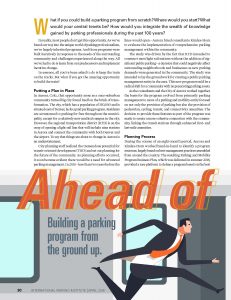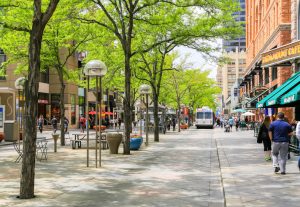 By Robert Ferrin and Brett Wood, PE, CAPP
By Robert Ferrin and Brett Wood, PE, CAPP
Building a parking program from the ground up.
What if you could build a parking program from scratch? Where would you start? What would your central tenets be? How would you integrate the wealth of knowledge gained by parking professionals during the past 100 years?
In reality, most people don’t get this opportunity. As we’ve found our way into the unique world of parking professionalism, we’ve largely inherited programs. And those programs were built iteratively in response to the needs of the surrounding community and challenges experienced along the way. All we’ve had to do is learn from our predecessors and implement iterative change.
In essence, all you’ve been asked to do is keep the train on the tracks. But what if you got the amazing opportunity to build the train?
Putting a Plan in Place
In Aurora, Colo., that opportunity arose as a once-suburban community turned big city found itself on the brink of transformation. The city, which has a population of 350,000 and is situated east of Denver, lacks a paid parking program. Residents are accustomed to parking for free throughout the municipality, except for a relatively new medical campus in the city. However, the regional transportation district (RTD) is on the cusp of opening a light rail line that will include nine stations in Aurora and connect the community with both Denver and the airport. To say that things are about to change in Aurora is an understatement.
City planning staff realized the tremendous potential for transit-oriented development (TOD) and set out planning for the future of the community. As planning efforts occurred, it soon became evident there would be a need for advanced parking management. In 2015—less than two years before the lines would open—Aurora hired consultants Kimley-Horn to evaluate the implementation of comprehensive parking management within the community.
The study was driven by the fact that RTD intended to construct most light rail stations without the addition of significant public parking—a decision that could negatively affect surrounding neighborhoods and businesses as new parking demands were generated in the community. The study was intended to lay the groundwork for creating a public parking management entity in the area. This new program would be a radical shift for a community with no preexisting parking assets.
As the consultants and the City of Aurora worked together, the basis for the program evolved from primarily parking management to more of a parking and mobility entity focused on not only the provision of parking but also the provision of pedestrian, cycling, transit, and connectivity amenities. The decision to provide these features as part of the program was made to create a more cohesive connection with the community, linking the transit stations through enhanced first- and last-mile amenities.
Planning Process
During the course of an eight-month period, Aurora and Kimley- Horn worked hand-in-hand to identify a program structure, largely based on best-management practices assembled from around the country. The resulting Parking and Mobility Program Business Plan, which was delivered in summer 2015, provided a rare platform to define a program based on the best our industry has to offer. Throughout the project, we joked that Aurora had the opportunity to create a parking utopia, where they learned from all the lessons of the many communities that had previously braved this transition. Before long, what was a funny line became a mantra for the project, with these central tenets:
- The community, including the customer and the economic vitality of the community, is the most important aspect of the program.
- It’s about so much more than parking; the system should be a conduit for improving mobility, access, and growth within the community.
- Enforcement should be based on compliance and education rather than on heavy-handed regulations.
- Technologies should be designed to be easy to use for both the customer and the manager.
- The staff should act as ambassadors for the program, helping the community learn about how and why we manage parking.
- The community should be engaged throughout the life of the program, helping define the future by providing feedback.
- Decisions should be made based on real data from the community, ensuring that new program elements meet the needs of those they serve.
- Parking should be priced to manage demand and promote community needs, not generate revenue.
- Any positive revenue generated by the parking program should be reinvested into the community.
Central to these themes was the concept of building the program around the community. Utopia doesn’t have to mean cutting-edge technologies, progressive policies, or innovative strategies. Simply put, the Aurora Parking and Mobility Program should be built with the success of the community and program in mind.
Implementing the Plan
As the parking and mobility manager for a brand-new program within a city, what would your first task be? How would you implement a comprehensive business plan in a mere 12 months? Being the first parking and mobility manager for the City of Aurora means having the opportunity to be in an exciting position to help shape a program that puts the customer first and is about much more than parking.
With that excitement also come challenges related to a lack of infrastructure and history. The Aurora Parking and Mobility Program Business Plan serves as the city’s guiding policy document but also very specifically outlines action items that need to be implemented with a phased approach. These action items serve as the foundation of a work plan that will create a program from the ground up to support neighborhood access, promote economic development, and drive ridership to Aurora’s new light rail line opening at the end of the year.
Implementation of the business plan required a multi-pronged approach focused on education and outreach, municipal code development, contracting, and the establishment of fees and permitting. Because parking touches so many of the daily functions of a city, an interdepartmental team was formed of professionals from seven different departments, all working together to create the program.
A series of public meetings was held, with more being scheduled, to educate the public about the proposed neighborhood parking permit program. In the public meetings, residents learn how the program will benefit them and provide access to their communities after light rail operations commence.
Working meetings were established with the city attorney’s office to revise a municipal code that included little to nothing about parking programs, enforcement, or citation adjudication. Finally, requests for proposals (RFPs) and contracts were executed to implement what will be a completely outsourced implementation of the parking and mobility program.
A true team effort, Aurora’s first parking facility opened in March with the completion of a conference center hotel project. Much has been accomplished, yet much is left to complete on the action item list.
What’s Ahead?
As a cornerstone of the program’s development, Aurora will continue to provide education and outreach to residents, businesses, and city departments regarding the benefits of a holistic parking management system. The city will be contracting with a qualified parking services vendor in the late summer to implement the municipal operations side of the parking and mobility program, including managed on- and off-street parking, enforcement, and the issuance of parking permits. The program is also deeply involved in economic development and redevelopment opportunities to identify how parking can assist in furthering Aurora’s urban development vision around nine new TOD sites. And finally, the city is continuing to work with transportation partners, such as car share and shuttle operators to provide additional mobility options to residents, businesses, and visitors. It is an exciting time for Aurora, with many changes on the way. Stay tuned to find out if Aurora achieves parking utopia with the implementation of the parking and mobility business plan.
ROBERT FERRIN is parking and mobility manager with the City of Aurora, Colo. He can be reached at rferrin@auroragov.org.
BRETT WOOD, PE, CAPP, is a parking and transportation planner with Kimley-Horn. He can be reached at brett.wood@kimleyhorn.com.
TPP-2016-04 Ahead of the Train
 By Michelle W. Jones, CMP
By Michelle W. Jones, CMP
